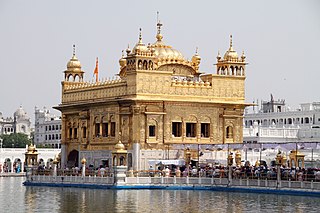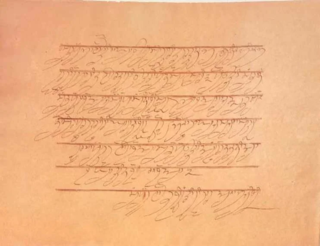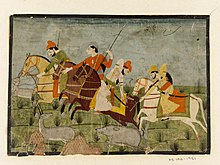
Sikhism, also known as Sikhi, is an Indian religion and philosophy in particular for the Sikh ethnoreligious group that originated in the Punjab region of India around the end of the 15th century CE. The Sikh scriptures are written in the Gurumukhi script particular to Sikhs. It is one of the most recently founded major religious groups and among the largest in the world, with about 25–30 million adherents.

A gurdwara or gurudwara is a place of assembly and worship for Sikhs but its normal meaning is place of guru or "Home of guru". Sikhs also refer to gurdwaras as Gurdwara Sahib. People from all faiths and religions are welcomed in gurdwaras. Each gurdwara has a Darbar Sahib where the Guru Granth Sahib is placed on a takht in a prominent central position. Any congregant may recite, sing, and explain the verses from the Guru Granth Sahib, in the presence of the rest of the congregation.

Khalsa refers to both a community that considers Sikhism as its faith, as well as a special group of initiated Sikhs. The Khalsa tradition was initiated in 1699 by the Tenth Guru of Sikhism, Guru Gobind Singh. Its formation was a key event in the history of Sikhism. The founding of Khalsa is celebrated by Sikhs during the festival of Vaisakhi.
Adherents of Sikhism follow a number of prohibitions. As with any followers of any faith or group, adherence varies by each individual.
The following outline is provides an overview of Sikhism, or Sikhi.

Gurbani is a Sikh term, very commonly used by Sikhs to refer to various compositions by the Sikh Gurus and other writers of Guru Granth Sahib. In general, hymns in the central text of the Sikhs, the Guru Granth Sahib, are called Gurbani. Among Amritdhari Sikhs, a few texts from Dasam Granth which are read as Nitnem, like Tav-Prasad Savaiye and Chaupai, are also considered Gurbani. In Adi Granth, Gurbani is a sound which comes directly from the Supreme and the text is a written form of the same in worldly language and scripts. It is also called Guru’s Bani. Gurbani are explanations of qualities of the Primal Lord and Soul which a Sikh should comprehend and with which they can attain the supreme state.

The Damdamī Ṭaksāl, also sometimes referred to as Giani Samparda, Jatha Bhindra(n), or Sampardai Bhindra(n) is an orthodox Khalsa Sikh cultural and educational organization, based in India. They are known for their teachings of vidya as well as gurbanisanthiya. Its headquarters are located in the town of Mehta Chowk, approximately 40 km north of the city of Amritsar. It has been described as a seminary or “moving university” of the Sikh countryside.

The Akhand Kirtani Jatha, alternatively romanized as the Akhand Keertanee Jathaa and abbreviated as AKJ, is a jatha and sect of Sikhism dedicated to the Sikh lifestyle. The Jatha follows a strict discipline in keeping the Rehat of Guru Gobind Singh. They also enjoy an active style of Keertan recited by Sikhs in a collective manner in front of Guru Granth Sahib. This style of Keertan is relatively simple, and the entire congregation devotionally participates in singing along.

The practice of vegetarianism is strongly linked with a number of religious traditions worldwide. These include religions that originated in India, such as Hinduism, Jainism, Buddhism, and Sikhism. With close to 85% of India's billion-plus population practicing these religions, India remains the country with the highest number of vegetarians in the world.

Nitnem is a collection of Sikh hymns (Gurbani) to be read minimally 3 different times of the day. These are mandatory and to be read by every Amritdhari Sikh as expressed in the Sikh Rehat Maryada. Optionally additional prayers may be added to a Sikh's nitnem. There are five hymns (Five Banis) to be done during Amrit Vela, the Rehras Sahib hymn for the evening and Kirtan Sohila for the night. The morning and evening prayers should be followed by an Ardaas.
Islam is an Abrahamic religion founded in the Arabian Peninsula, while Sikhism is an Indian religion founded in the Punjab region of the Indian subcontinent. Islam means 'submission to god'. The word Sikh is derived from a word meaning 'disciple', or one who learns.
Rehat refers to the rules and traditions which govern the unique Sikh lifestyle and determines correct Sikh orthodoxy and orthopraxy. The Sikh Rehit Maryada is a code of conduct and conventions for Sikhism. The final version of the Rehat Maryada was controversially approved by the Shiromani Gurdwara Parbandhak Committee, Amritsar in 1945. The Rehat Maryada was created to provide guidance to Sikhs on practical and functional aspects of daily life, including the operations of Sikh Gurdwaras, and religious practices to foster cohesion throughout the community. Rehitnāma is a Punjabi term that refers to a genre of Sikh religious literature which expounds upon specifiying an approved way of life for a Sikh.

Chandi Di Var also known as Vaar Durga Ki is a composition written by Guru Gobind Singh, included in the 5th chapter of Dasam Granth.
The Sikhs engage in various rites and services. Sikh rites include activities they consider essential to the group practice of Sikhism or the expression of egalitarianism, such as kirtan or taking karah parshad. Many rites in Sikhism involve prayer (ardas) or reciting scripture (paath). Some Sikh rites are meant to be practiced in a gurdwara congregation, while others are practiced at home or in other contexts.
Jhatka, or Jhataka, is the meat from an animal killed by a single strike of a sword or axe to sever the head within the Sikh religion, which kills the animal almost instantly as opposed to other forms of slaughter. This type of slaughter is preferred by most Sikhs, as well as meat-consuming Hindus and Buddhists. Also within this method of butchering the animal must not be scared or shaken before the slaughter.
The following list consists of concepts that are derived from both Sikh and Indian tradition. The main purpose of this list is to disambiguate multiple spellings, to make note of spellings no longer in use for these concepts, to define the concept in one or two lines, to make it easy for one to find and pin down specific concepts, and to provide a guide to unique concepts of Sikhism all in one place.

Jhatka Parkash ,also called Jhatka Parkash Granth, is a book written by Giani Niranjan Singh Saral, a leading preacher of the SGPC, concerning historical, philosophical, etymological and theological aspects of Jhatka and Meat eating in Sikh Religion.

Amrit Velā does not refer to a specific time. According to the pahar system of time, most Sikhs typically interpret this time to start at around 3:00 a.m. Guru Nanak in the Japji Sahib says, "in amrit velā meditate on the grandeur of the one true Name". The importance of Amrit Vela is found throughout the Guru Granth Sahib. The Guru Granth Sahib states that "those who consider themselves a Sikh must wake up daily at Amrit vela and be in tune with the Naam "

Sikh sects, denominations, traditions, movements, sub-traditions, also known as sampardai in the Punjabi language, are sub-traditions within Sikhism that believe in different approaches to practicing the religion. All sampradas believe in the One Creator God typically rejecting both idol worship and caste systems. Different interpretations have emerged over time, some of which have a living teacher as the leader. The major historic traditions in Sikhism, states Harjot Oberoi, have included Udasi, Nirmala, Nanakpanthi, Khalsa, Sahajdhari, Namdhari Kuka, Nirankari and Sarvaria.

The Jathedar of the Akal Takht is the head of the Akal Takht and head of the Sikhs worldwide. The jathedar has the de facto power as the supreme spokesperson of the Khalsa to summon, trial and sentence any person who identifies as a Sikh from the Akal Takht.














